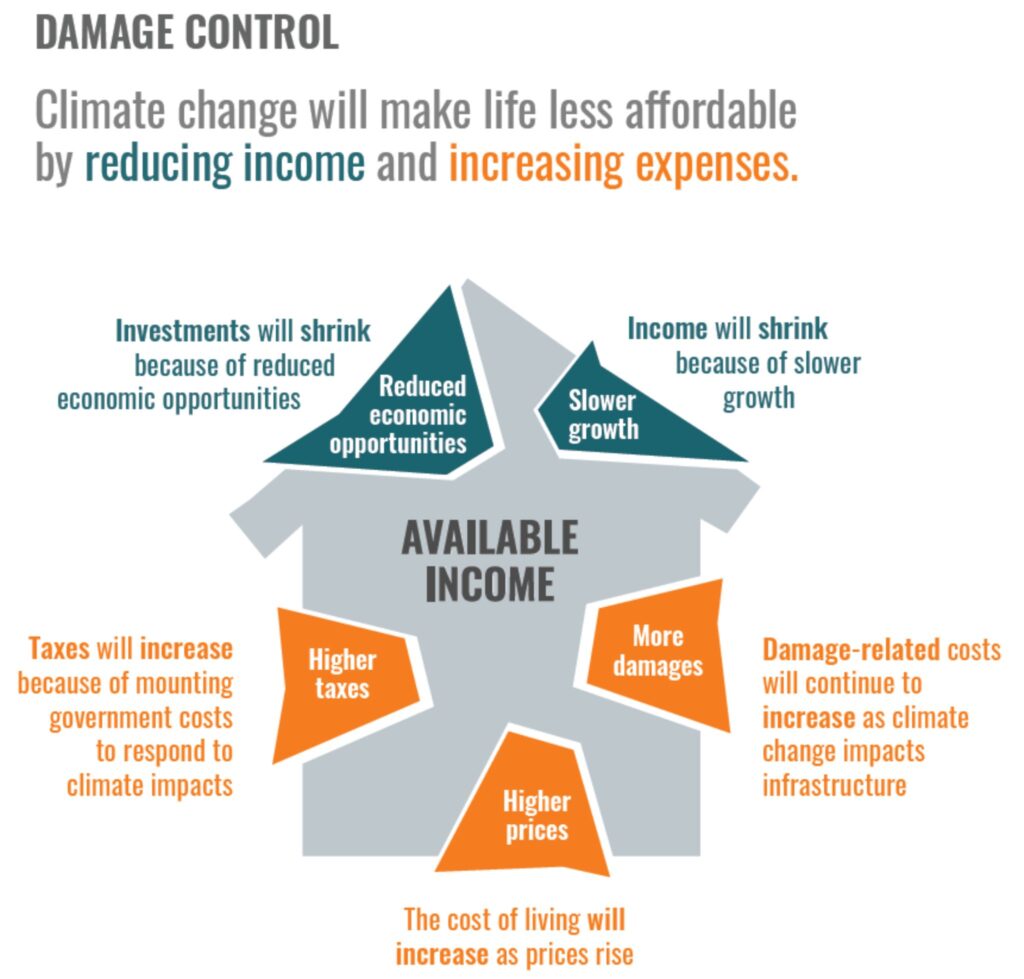
Report: Canada’s economy already hurt by climate change, households hit hardest
September 28, 2022
By Canadian Climate Institute
New report from the Canadian Climate Institute shows climate damages are already impairing Canada’s economy and will cut growth in half by 2025.
 Image: Canadian Climate Institute
Image: Canadian Climate Institute A report released today by the Canadian Climate Institute shows that the mounting costs of a volatile climate are already dragging down Canada’s economy, with these costs rising swiftly in the coming years.
The report – Damage Control: Reducing the costs of climate impacts in Canada – examines the macroeconomic costs of climate change, assessing them in both low- and -high emissions scenarios relative to a stable-climate scenario. The analysis shows that climate impacts will cost Canada billions, making life less and less affordable for households as economic growth slows, governments raise taxes to pay for climate disasters, job losses increase, and goods become more expensive due to disrupted supply chains.
“The cost of inaction when it comes to climate change is measurable and mounting. We need to put adaptation and mitigation measures in place now to avoid severe damage to our economy, society, health, and well-being,” said Rick Smith, president of the Canadian Climate Institute.
The report, which is a culmination of a five-report series and the most comprehensive macroeconomic analysis of climate change in Canada to date, also presents solutions. Proactive adaptation measures and policies can limit climate change damage, cutting the projected costs in half, saving billions of dollars, and making life more affordable for households. A dollar invested in proactive adaptation measures, the report finds, can return $13-$15 in direct and indirect benefits. And if adaptation measures are combined with global emissions reductions, future costs could be reduced by three-quarters, putting Canada on a path to a more stable and affordable future.
Key findings from Damage Control:
- Climate-induced damages are already here and they’re adding up. By 2025, climate impacts will be slowing Canada’s economic growth by $25 billion annually, which is equal to 50 per cent of projected GDP growth.
- All households will lose income, and low-income households will suffer the most. Low-income households could see income losses of 12 per cent in a low emissions scenario and 19 percent in a high emissions scenario by the end of the century—markedly higher losses than the median income group.
- Climate change is a job-killer. Job losses could double by mid-century, and increase to 2.9 million by end-of-century.
- Adaption pays off big. Every dollar spent on adaptation measures saves $13-$15, including both direct and indirect economy-wide benefits.
- Limiting further warming, while adapting to the warming already baked in, pays off bigger. Taking proactive adaptation measures cuts climate costs in half, and if these are combined with global mitigation measures, then costs are cut by three-quarters.
“The findings couldn’t be clearer: Canada is directly in the crosshairs of a changing climate. The economy is highly sensitive to this threat, and we’re already paying the costs: as early as 2025, the damages will have cut Canada’s growth rate in half. We need to reckon with these massive costs and do everything we can to limit the damage,” said Dave Sawyer, principal economist with the Canadian Climate Institute.
“The economic consequences of climate change are only now coming into view, and this report provides thoughtful insights on just how climate change could impact the Canadian economy,” said Susan McGeachie, head of BMO Climate Institute at BMO Financial Group. “The threat is real, but, fortunately, there’s much that can be done to limit the damages. Investing in adaptation and resilience today will help protect Canada’s economy and could save lives. Taking proactive adaptation measures can cut the costs of climate change impacts and provide a strong return on investment, saving money in the long-term while paving the way for a more sustainable and prosperous future for Canadians.”
Print this page